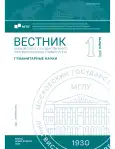Rhoticity Revisited
- 作者: Elena B.1
-
隶属关系:
- Moscow State Linguistic University
- 期: 编号 1(895) (2025)
- 页面: 38-44
- 栏目: Linguistics
- URL: https://journal-vniispk.ru/2542-2197/article/view/279181
- ID: 279181
如何引用文章
全文:
详细
The purpose of the research is to outline the basic state-of-the-art information about the status of such a sociolinguistic variable as rhotacism in the diversity of Englishes. Both diachronic and synchronic analyses of the problem are provided. The topicality of the problem lies in the necessity of choosing the type of pronunciation in terms of “rhoticity-nonrhoticity” in teaching English. In the Inner-circle countries the degree of rhoticity depends on the history of the language development, on the speakers’ age, gender, socio-economic status. In the Outer circle countries it depends on the substrate language influence, the norm orientation of mass media and education, the government policy, on mixed marriages. It is important to note that rhoticity in Great Britain and in the United States develops in opposite directions.
作者简介
Buraya Elena
Moscow State Linguistic University
编辑信件的主要联系方式.
Email: helen812@list.ru
SPIN 代码: 9939-0764
俄罗斯联邦
参考
- Wells, J. C. (1982). Accents of English (vol. 1. An Introduction): in 3 vols. Cambridge: Cambridge University Press.
- Gordon, E. at al. (2004). New Zealand English. Its Origins and Evolution. Cambridge: Cambridge University Press.
- Turton, D., Lennon, R. (2023). An acoustic analysis of rhoticity in Lancashire, England. Journal of Phonetics, 101. 10.1016/j.wocn.2023.101280.
- Fisher, J. H. (2001). British and American, Continuity and Divergence. In Algeo, J. (Ed.), The Cambridge History of the English Language (vol. VI: English in North America, pp. 59–85): in 6 vols. Cambridge: Cambridge University Press.
- Labov, W. (2006). The social stratification of English in New-York City. Cambridge: Cambridge University Press. 2nd ed.
- Trudgill, P., Hannah, J. (2013). International English: A Guide to the Varieties of Standard English. Routledge. 5th ed.
- Nagy, N., Irwin, P. (2010). Boston (r): Neighbor(r)s nea(r) and fa(r) Language Variation and Change, 22(2), 241–278.
- Trudgill, P. (1986). Dialects in Contact. Oxford: Blackwell.
- Trudgill, P. et al. (2000). Determinism in new-dialect formation and the genesis of New Zealand English. Journal of Linguistics, 2, 299–318.
- Villarreal, D. et al. (2021). Gender separation and the speech community: rhoticity in early 20th century Southland New Zealand English. Language Variation and Change, 33(2), 245–266.
- Trudgill, P., Gordon, G. (2006). Predicting the past: Dialect archaeology and Australian English rhoticity. English World-Wide, 27(3), 235–246.
- Bowerman, S. (2004). White South African English: phonology. In Schneider, E. et al. (Eds.), A Handbook of Varieties of English (vol. 1: Phonology, pp. 931–942): in 2 vols. . Berlin–NY: Mouton de Gruyter.
- Hartmann, D., Zerbian, S. (2009). Rhoticity in black South African English – a sociolinguistic study. Southern African linguistics and applied language studies, 27(2), 135–148.
- Li, Z., Kabak, B. (2017). Rhoticity in Chinese English: An experimental investigation on the realization of the variant (r) in an Expanding Circle variety. Alicante Journal of English Studies, 30, 61–91.
- Sharbawi, S., Deterding, D. (2010). Rhoticity in Brunei English. English World-Wide, 31(2), 121–137.
- Tan, Y.-Y. (2012). To r or not to r: social correlates of /ɹ/ in Singapore English. International Journal of the Sociology of Language, 218, 1–24.
- Marsden, Sh. (2017). Are New Zealanders “rhotic”?: The dynamics of rhoticity in New Zealand’s small towns. English World-Wide, 38(3), 275–304.
补充文件










